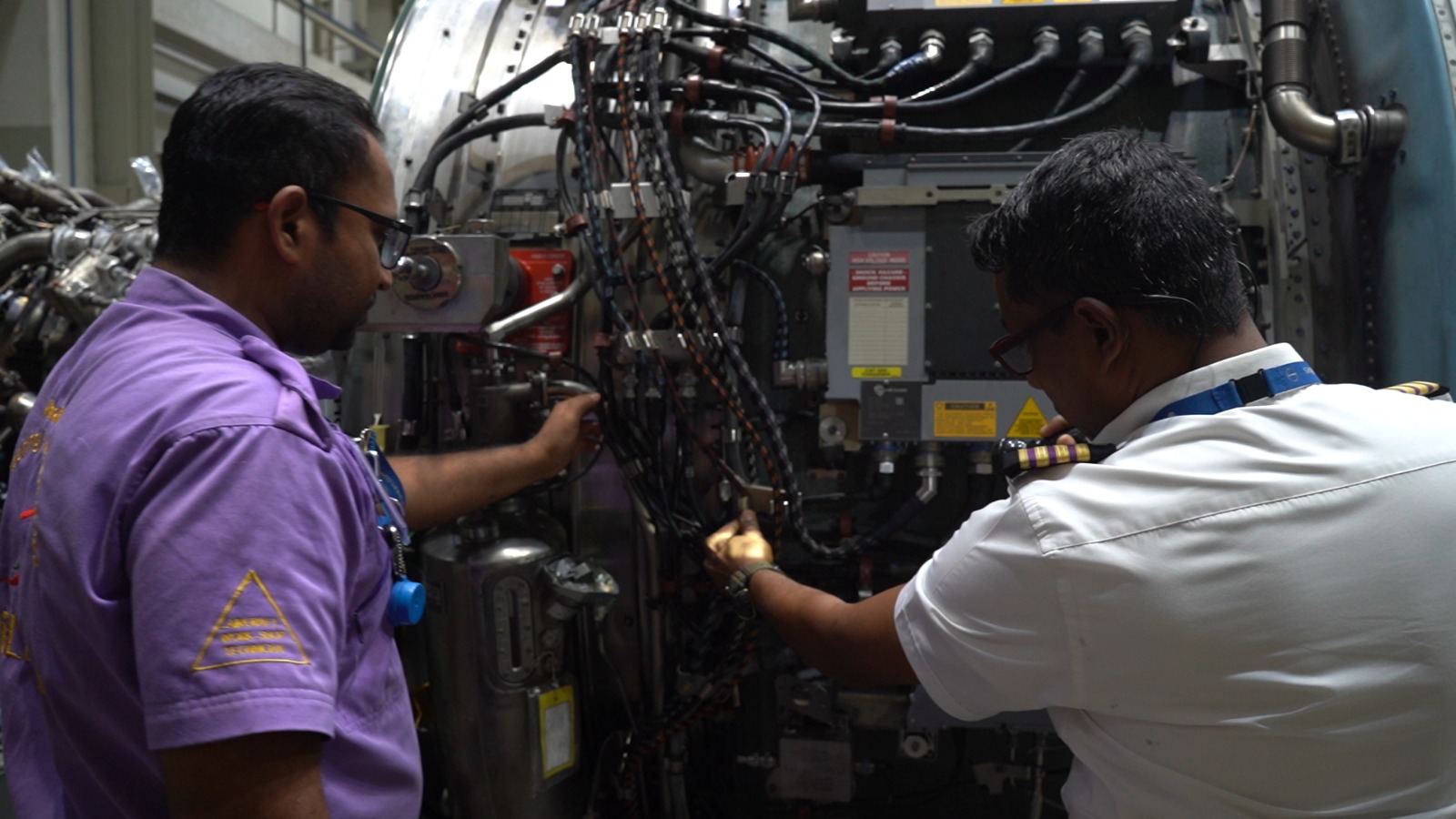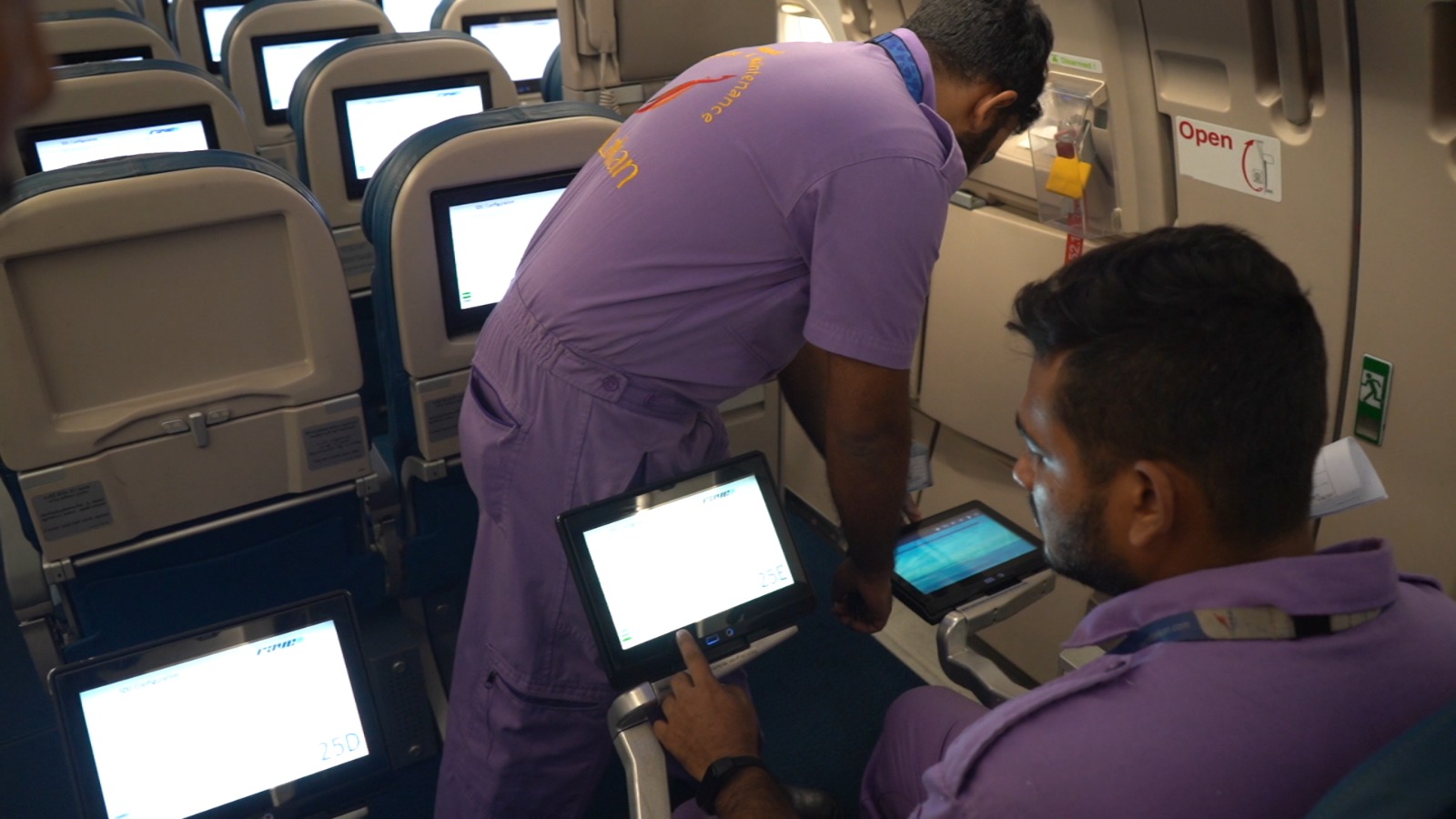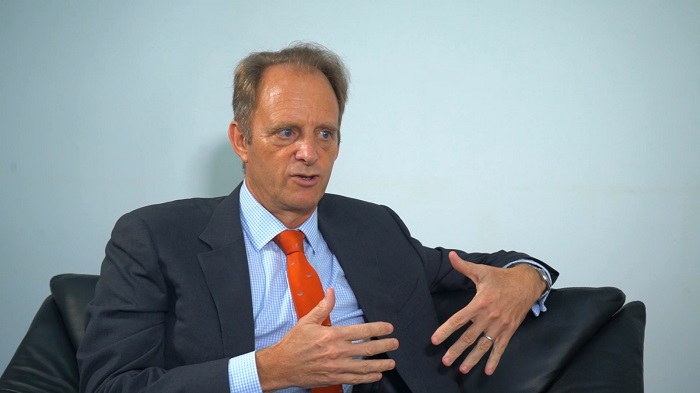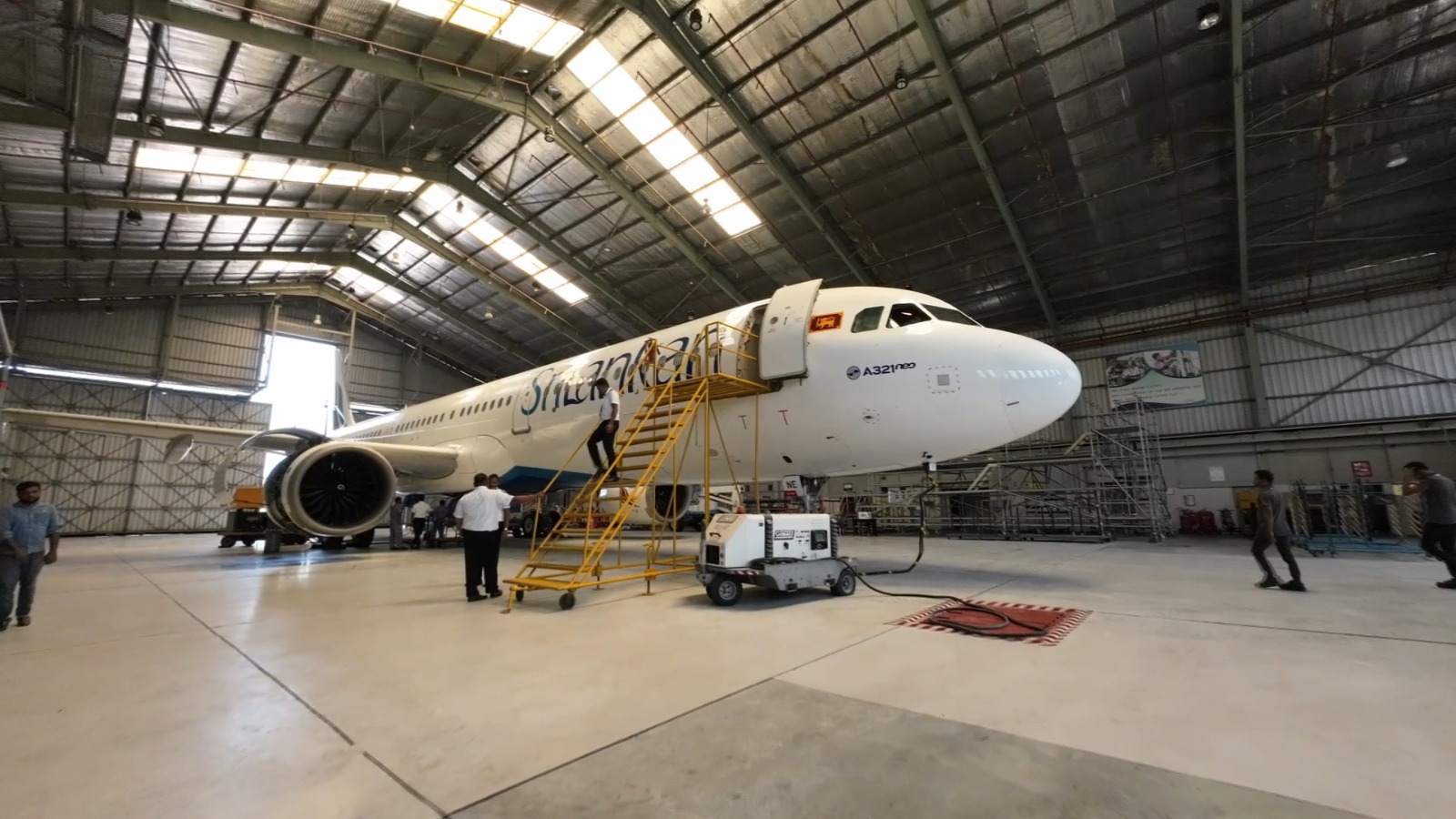Sri Lanka’s National Carrier, SriLankan Airlines, is determined to bounce back despite facing various challenges in the recent past.
Having reported significant profits in the post-coronavirus pandemic period, the airline has, however, faced backlash recently due to delayed and cancelled flights.
The CEO of SriLankan Airlines, Richard Nuttall sat down with NewsWire to answer some pressing questions on the issues surrounding the airline.
Q. Would you give us some overall background of the situation of SriLankan Airlines at present?
A. The airline at the moment, like many airlines, is recovering after the pandemic period. We’ve got some added issues from Sri Lanka as well. I guess the world is still not back to normal. A lot of airlines lost a lot of money during that time. There was massive government funding or funding from elsewhere that people are, and every airline is trying to pay back. But at the same time, we are in a strange world where capacity is constrained.
What it means is that fares are high. While it’s gradually returning to normal in some parts of the world, at an average level, It’ll probably stay high for another year or two. What that is allowing is for people to sort of catch up with the past and with their past debts.
We are no different. We don’t have our full capacity flying. It’s very difficult to get new aircraft at the moment. There’s a lot of engines on the ground, and that’s a global phenomenon. We are flying with maybe 70% of our pre-COVID traffic capacity. But all of that money is going off to pay for the debts of the past, of which some were generated during COVID.
Q. The general perception is that SriLankan Airlines is considered a debt on its own to the nation, due to the massive debt it carries. What do you have to say about this?
A. I think we have not taken any money from the country since March 21. The reality is during COVID, the world’s airlines got financial support to the tune of 200 billion US dollars. We got just over 200 million. We are no different to any other airline. The reality is that there are many countries where you have government airlines, and the government supports them a little bit because economic growth goes hand in hand with the airlines.
We are now paying interest at what are now globally and locally high interest rates on a billion dollars of debt. That’s the challenge. But, if you compare it with many other national airlines, the cost to the economy is not different. However, Sri Lanka doesn’t have a lot of cash to spare at the moment.
Q. Recently, we have seen a lot of negative publicity about SriLankan Airlines, especially complaints from passengers about flight delays. Why is this happening?
A. There is a uniquely Sri Lankan phenomenon that says whenever there’s an incident, it goes in the press. Sometimes it’s true and sometimes it’s not true. It is a reality that I think all airlines have had operational issues after COVID. That comes from, I guess, two things.
One is the fact that globally there’s been a problem getting people back to work, particularly at airports. You have many airports and many providers where you don’t have enough people. The people that you’ve got are not necessarily that experienced. If you go back to last year, we experienced major delays in European cities, in Australia, even in Singapore. It’s not just a Sri Lankan phenomenon. So everybody’s had that issue, it’s global.
The second thing is that there are issues in terms of getting spares and getting engines. There have been supply chain problems. There’s not enough people working in maintenance and MROs. People left during the pandemic. Nobody was being trained as replacements. What it means is that airlines can’t get their aircraft in the sky fast enough. All of that means that you do have delays. Globally, I think you’ll find on time performances below where it was in 2019.
The reality is that safety is never compromised. Airlines don’t talk a lot about safety because if you talk about safety and you ever have an incident, then you’ve lost all credibility. But the reality is that everything in this industry is regulated. You have to change each part after so many cycles or so many flights. If you have an issue, there is a prescribed way that you handle it. If you want to fly the aircraft with something that’s not quite fixed, it’s absolutely written what you can do and what you can’t do.
We follow the civil aviation here which is very strong and we have our own regulations here. We also follow guidelines from EASA, which is the European agency. We have audits carried out by several international organizations. We follow manufacturer regulations. At the end of the day, if an aircraft is not fit to fly, it stays on the ground. If we don’t have enough engineers, an aircraft will stay on the ground before it can fly. There’s no compromise.

Q. Any recent measures you have implemented to reduce flight cancellations?
A. Well, so I talked earlier about the engine issues. I think the biggest challenge often is with new technology. The challenge that everybody has at the moment in the industry is with new technology engines. We had three out of six on the ground until about March of this year.
Then they implemented some new regulations for countries which were considered to be harsh for these engines, which were people flying in this part of the world and to the Middle East and India. They instituted new checks and we lost another couple of engines. Out of six aircraft, only one was flying for one or two months. We then also had an issue that we had some aircraft that were in long checks that needed spare parts, that again, because of supply chains, we couldn’t get quickly. We finished up at the end of June with 15 aircraft flying out of 23 for a short period of time. That was what was causing delays.
Your passengers are booked a month in advance. You’re trying to balance what you fly, what you cancel. When it gets a little bit tight, you know, then you have one failure or one technical. Then, you know, there’s, shall we say, a knock on effect. But now we’ve got many of those aircraft back in the sky. We’ve got 20 aircraft flying. Within a couple of months, we expect to be adding to that. The fleet more closely matches the schedule that we’ve got. It has been better for the last month and it should continue to be better.
Again, call centres are like everything else. There’s been a real challenge around call centres and we will be needing and requesting more people going forward. We’re trying to boost up the numbers. At the same time, we’re also looking to do more digitally so we can inform people when there are delays or when there are disruptions and what the solutions are faster and in advance.
One of the things that I will also say to anybody is that when you fly, please make sure that your mobile number is on your booking, your number and not the booking of your agent. Because at the moment, we send it when there’s a delay, we send an SMS to everybody. Those people who’ve got their own number, they get the message. Those people who’ve got their agent’s message, it depends whether the message comes during office hours for them to be informed. So if we’ve got your contact, then we can get you the information quite quickly. We could make better use of technology, which is what we do.
Q. If you look at the tourism industry, it depends on the airlines to bring people to Sri Lanka. The government at the moment speaks about bringing 5 million tourists in a few years. What is SriLankan Airlines’ role in achieving this target?
A. We believe over sort of 3 to 5 years, we should be looking to more or less double the size of the airline. The more you fly to places, the more traffic comes here, the more tourists come. When you want to go on holiday, you look where you might want to fly, but you also look where you have a flight. People want to go direct, they don’t want to go via. The more that we can fly and the more that we can grow Colombo as a hub, the more tourism that we’ll get.
I think the other thing I would say about tourism is that when you look at the promoters of tourism, we are the number one agency in the country that does that. We are the only people that have sales people on the ground and all of the major tourist people. They know all the major tour operators. They know the market and they’re in the market and they are trying to sell Sri Lanka day in day out. We play a huge role in promoting the country.

Q. There are talks about privatizing SriLankan Airlines. So how does that work? How do you see it?
A. I don’t think it really matters whether we’re privatized or not. I think the most important thing is that whoever owns us has the financial ability to support us and allow us to grow to the benefit of the country. If you look at the process that we’re going through as a state owned enterprise at the moment, that is well documented.
There are two parts. One is to try and tidy up the balance sheet. At the moment we’re spending 10 percent of revenues servicing debt and that is not sustainable. But if we can reduce what’s being used to service debt and we can use that money to invest in growing the airline, then we can be much stronger for the country in terms of both business traffic, bringing in tourism, and all of the benefits that that brings. If we privatize, maybe that will bring other benefits depending on who buys us, whether it brings funding for new projects, whether it brings expertise if it’s an airline.
But equally, there are advantages to being government owned. As an airline, we’re agnostic. The most important thing for us is that we can restructure the debt and then whoever owns us that they buy into the growth because that’s good for the airline, important for the airline and important for the country.
Q. What we hear from people is that SriLankan Airline fares are very high. Will the fares come down in the near future?
A. I think if you compare them with other carriers, particularly on nonstop products, you’ll find that we’re actually not that expensive. What is expensive is that globally fares have gone up because we have two things that have happened.
One is, again, because of lack of aircraft and lack of engines. You want to buy a new aircraft now. You can’t get one for five years. So everything is constrained. That means that airlines can charge more. And they do that because everybody’s trying to pay off debt and trying to pay for increased costs.
And so the other part of it is the cost. If you look at the moment, fuel is high. It’s not quite as high as it was last year, but it’s still very high in terms of historic levels. Everybody’s having trouble recruiting staff all across the infrastructure. So labour costs are high. Ground handling costs are high. This is global. Maintenance costs are high because there are issues with the supply chain.
You’ve got two things. You’ve got high costs and you’ve got constrained demand. I think that fares will stay high for a while. They are starting to come down in some parts of the world where the ecosystem has gotten closer to historic norms. So it will depend a little bit where you’re flying. Clearly over time they will get back to historic norms, but that might take a couple of years. It will depend on the market. But we’re certainly no more expensive than anybody else. I think historically SriLankan used to slightly undersell itself. If we’re going to be profitable going forward, we need to make sure that we’ve got the fares at the right level.

Q. Is SriLankan Airlines profitable now?
A. Yes. In US dollar terms, we are profitable and we will be profitable this year unless there’s a global incident that we can’t foresee.
In Sri Lanka, our finances are reported in Sri Lankan rupees because we’re a Sri Lankan company. But the reality is that most of our revenues come in foreign currency. Our fares in Sri Lanka are based on dollar fares. Most of our costs are in dollars. We do all of our management accounting in dollars because really we’re a foreign company in terms of economics.
Locally, things get skewed when you get a difference in exchange rates. So if you’ve got US$100 million debt and the Sri Lankan rupee halves in value, then everybody goes and reports that we’ve lost US$50 million equivalent in rupees. Well, that’s not true. It just means that the rupee valuation has changed. But in US dollar terms, which is how we earn our revenues and how we pay our costs, we’re profitable.
Q. Can you share some success stories from passengers that highlight the effectiveness of SriLankan Airlines?
A. I think the really good thing about SriLankan Airlines, and I’m not going to give you individual stories, but the good thing about SriLankan Airlines is that we’re small. So when things do go wrong, very often they get fixed.
When people have issues, the ones that don’t work so well get reported in the press. But there are hundreds of occasions every day when people have issues and our people are able to sort them out and help people get to their destination, reduce the angst of travel, solve whatever problems they may have. I think that’s one of the strengths of the airline.
Q. Pilots are one of the main key issues that come up in the media every few weeks, saying there is a shortage of pilots or pilots are leaving the country. What is the situation?
A. Pilots have left the country. I mean, not just pilots, but engineers, IT experts, accountants. Many people have left the country.
The reality is there are many airlines trying to get back to flying. Many of the Gulf carriers laid pilots off during COVID and they’re trying to recruit again as they grow. So there are many opportunities. Yes, people are leaving. At the same time, we are recruiting.
If you look at where we are today, we have enough pilots for today’s operation. We don’t have enough pilots for the operation we would like to have as we get into the middle of the winter next year. We are aggressively looking to recruit. The same applies to other parts of the airline. It’s a world where everything is a competition. We compete for passengers. We also compete for employees in some areas at the moment.
Q. When it comes to frequent flying at SriLankan Airlines, what advantages do you get?
A. The advantages from being a frequent flyer member are, first of all you can get miles which you can use for free flights or upgrades. You get different baggage allowances, you get access to lounges, you get priority if you have issues, you get priority handling. Those are the main ones. I guess the other one is that because we are part of OneWorld, you also get the same benefits on all the OneWorld carriers.
Q. When it comes to passenger safety, can you tell us how SriLankan Airlines puts safety first in their operations?
A. Everything that we do is very highly regulated. We get inspections from our own civil aviation, from EASA which is the European organization. The whole industry is regulated by what’s called IOSA audits which is an IATA program.
If you don’t pass your IOSA audit, you can’t fly to many airports in the world. We had our last audit last November which we passed with Flying Colours. We had major improvements in five years previously. A lot of work had been done at that time. As I say, if there is ever an issue with an aircraft, that aircraft stays on the ground. There’s no question about it. So you have a flight delay, it’s not because you have an aircraft that’s unsafe. It’s because we’re saying that aircraft is not going to fly unless it’s safe.

Q. Can you share some examples of special initiatives or programs the airline has now implemented to increase the passenger experience?
A. The two big things at the moment are in-flight. We’ve always been known for our hospitality in-flight but we’re working on Sri Lankanizing the experience. We’re trying to improve the food, we’re trying to give more choices, we’re having more regular changes. We’re looking to make sure that we have Sri Lankan products on board.
As everybody gets back, we’re now in a situation where training stopped a little bit during COVID or it was online. We can now do much more experiential training for our customer service employees, whether that’s at the airport or whether that’s on the ground.
I think the big pain point for everybody at the moment is really the airport. It’s not in-flight. That has been challenging. We’ve had the same issues as everybody else in terms of recruiting staff for the airport. There was a lag in getting approvals and then you have to train people. But we’re catching up on that. And if you go out to the airport now, you’ll see a lot of people that are out there queue-combing and making sure that you’re in the right place.It’s more of a stress factor. I mean, hardly any flights have been delayed for ground handling and for the passengers getting people through check-in. If they have, it’s been five minutes. Very, very few. But it’s more of an angst and a stress thing. The problem we have is that we’re operating in an airport in which the passenger traffic is over capacity for the airport. But what we’re doing is we’re making sure that we’ve got more people there to queue-comb, make sure people are in the right place. If people have a question, there’s somebody they can see and they can talk to. We’re working on different options for setting up the queues.
The final thing that we’re putting in that we’re working on now is self-check-in. We’ve now got some kiosks out at the airport. We’ve got five now. We’re just working through. We’re doing trials so that people can actually go in. When there’s a long queue, they check in at the kiosk. There’ll be somebody there at the kiosk to help them if they have visa issues and to do all the document checks. They can tag their own bag. There’s a dedicated counter where they take the bag. They can bypass all of this long queue. If that’s successful, then we’ll look to add more self-service kiosks. That will be a way of adding capacity while we get through this period where we need to wait for the new terminal.
Q. If there is one message you would like to give to the Sri Lankan public about the SriLankan Airlines, what would it be?
A. Believe in your airline. There are people out there in Sri Lanka who love to go out and put negative stories.Often those are small things that happen in any airline.
We carry 5 million people a year. Unfortunately, every now and again, somebody will have a bad experience. But that doesn’t mean it’s the end of the world and that your carrier is not performing.
We are putting in systems. We’re going to be measuring ourselves much more using things like MPS. How we’re doing is not one passenger, but it’s what’s our average over the 4 million, 5 million passengers that we carry. You have a very good national carrier and we have a very strong reputation. If you look at how we’re perceived outside the country, it’s much stronger than inside the country. In other parts of the world, you don’t report every time there’s a flight delay. People here love to talk about queues at the airport. I just wonder how many of them have seen Dubai during the transit rush or Heathrow at busy times. The queues here are nothing. We have a small terminal, so they sometimes look worse. But, the service here is pretty good.
You have a good airline. We can be profitable. We’re very important to the growth of the country. So I’d like to see people get behind the airline a little bit more rather than enjoying the national pastime of trying to knock down its own treasures. (NewsWire)
